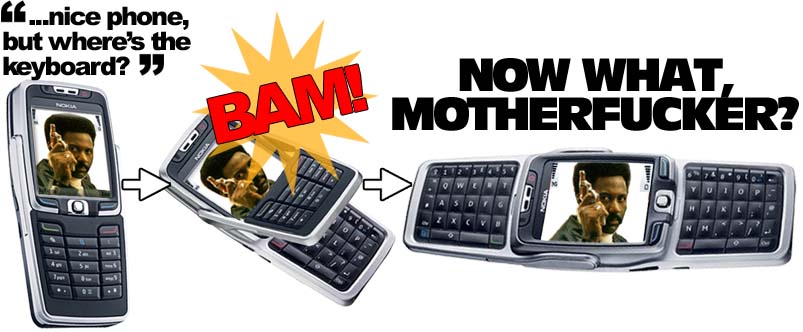Giving praise to the Nokia E70 must never stop. Since it appeared on this planet in May 2006, it is the killer of all. As thebestpageintheuniverse says: “Your iPhone is a piece of shit and so is your face” compared to my E70, which could probably even revive Michael Jackson.
Here the grafik stolen from bestpage:

What I achieved today reaches a solid 1000 on my personal geekness scale. I bought joikuspot which is a – legen-waitforit-dary WIFI HOTSPOT for symbian os. Yes, it uses the builtin Wifi functionality of the E70 (rocking, eh? wifi in your phone 2006!) as a hotspot instead of a client. To be precise, as a wifi p2p connection.
Alas, I am now sitting with my Apple laptop here, my phone next to me and enjoying a zeroconf-like connection to the internet. No bloody bluetooth, no labyrinthesk setup of modem over bluetooth over serial over your grandmas bra. Just plain old “wifi network name, WEP key, GO”. That includes you, my friend. next time you drop by and need web with your laptop but don’t have one ready, I am there for you.
OMG OMG. I mean, the last years, all these days when we did street art and mobile clubbings, permanent breakfasts, etc – now with that access point – multiple people can upload shit to the web in parallel. everywhere. This was what I always wanted: a small battery powered device you put into a room, press a button, say “this room now got internet, welcome to the future”. With no bloody WIFI UMTS usb dongle. Next thing, they will implement beaming for the E70.
Ok, but the reason for my enthousiasm is, that next, I am going to buy the amnazing http://www.eye.fi/. That is, a whopping SD card with Wifi client – get the picture? Take a picture, press “protect” on the cam, the SD card uses TCP/IP to connect to a service at eye.fi, which then uploads the pic directly from the fat32 filesystem of your camera to flickr. awesomeness, here I come…

